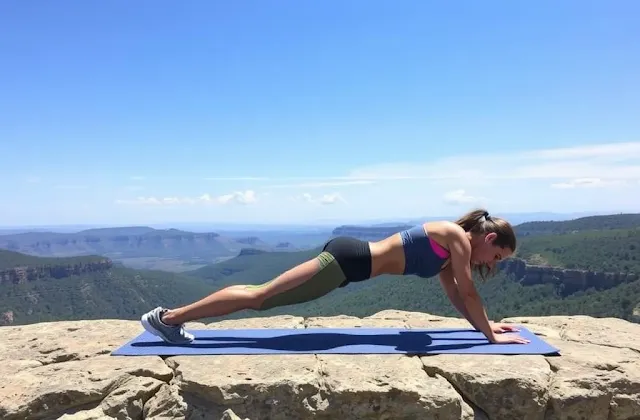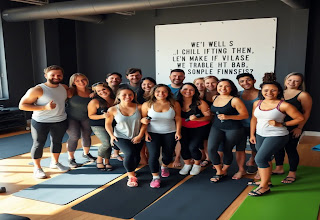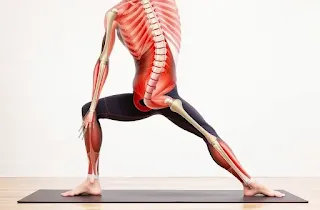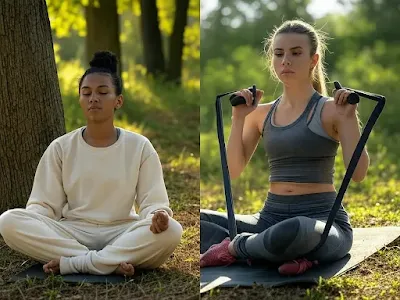Beyond the Six-Pack: Are You Training Your Core All Wrong?
Introduction:
Are you tired of the same old promises of "six-pack abs" and "rock-hard cores" that seem to dominate the fitness landscape? Do you, as a woman, ever feel like these promises are unattainable and fundamentally misaligned with your unique needs and goals? It's time to challenge the conventional wisdom surrounding core strength and embark on a journey to redefine what it truly means to have a strong and supportive core.
 |
| Beyond the Six-Pack: Are You Training Your Core All Wrong? |
Section 1 Title: Unlocking the Secrets of Your Core: More Than Just Visible Abs
Beyond the Six-Pack: We're talking about more than just therectus abdominis .A 3D Network: Encompassing muscles from your diaphragm to your pelvic floor.Functional Fitness: Supporting movement and stability in everyday life.
 |
| Beyond the Six-Pack: Are You Training Your Core All Wrong? |
But here's the catch: Failing to address
Pelvic Floor Health: Essential for bladder control, sexual function, and core stability.Diastasis Recti: Addressing abdominal separation after pregnancy.Postural Alignment: Maintaining proper alignment to prevent pain and injury.Breathing Mechanics: Utilizing proper breathing to engage the core effectively.
This is about building a core that supports you – literally and figuratively – through all of life's challenges. A core that empowers you to lift heavy objects, play with your kids, pursue your passions, and feel confident and strong in your own skin. It's time to redefine what "core strength" means to you.
Section 2 Title: The Deep-Down Powerhouse: The Psoas Muscle and Its Vital Role
Have you ever heard of the psoas muscle? Chances are, unless you're a dedicated yogi, Pilates enthusiast, or movement specialist, it's a muscle you've likely overlooked. But let me tell you, this deep-seated muscle is an absolute powerhouse when it comes to core strength, stability, and overall well-being, especially for women.
Hip Flexion: It's your primary hip flexor, responsible for lifting your knee towards your chest – essential for walking, running, climbing stairs, and even getting out of a chair.Spinal Stabilization: It acts as a crucial stabilizer for your lumbar spine, helping to maintain proper alignment and prevent lower back pain.Postural Support: It plays a key role in maintaining upright posture, counteracting the pull of gravity and preventing you from slouching forward.Force Transmission: It facilitates the smooth and efficient transfer of forces between your upper and lower body during movement.
Lower Back Pain: A tight psoas can pull on the lumbar spine, causing pain and stiffness.Hip Pain and Stiffness: Limited hip flexibility and discomfort during movement.Postural Imbalances: Anterior pelvic tilt, swayback posture, and rounded shoulders.Digestive Issues: A tight psoas can compress abdominal organs, leading to digestive discomfort.Menstrual Problems: Exacerbation of menstrual cramps and pelvic pain.Emotional Imbalance: Feelings of anxiety, fear, and insecurity.
 |
| Beyond the Six-Pack: Are You Training Your Core All Wrong? |
So, how do you unlock the power of your psoas and create a stronger, more balanced core? It starts with awareness. Pay attention to your posture, your movement patterns, and your stress levels. Incorporate exercises that stretch and release the psoas, such as hip flexor stretches, bridge variations, and gentle yoga poses. Strengthen your supporting muscles, including your glutes, hamstrings, and abdominal muscles. And practice mindful movement techniques, such as Pilates and yoga, to improve your body awareness and promote optimal alignment.
Psoas Release Techniques: Gentle stretches and myofascial release to alleviate tension.Strengthening Supporting Muscles: Glute bridges, hamstring curls, and abdominal exercises.Mindful Movement Practices: Yoga, Pilates, and Tai Chi to improve body awareness.Postural Correction: Consciously maintaining proper alignment throughout the day.Stress Management Techniques: Meditation, deep breathing, and mindfulness to calm the nervous system.
By nurturing your psoas, you're not just building a stronger core; you're investing in your overall health, well-being, and emotional resilience. You're creating a foundation for a more balanced, vibrant, and empowered life.
Section 3 Title: Reimagining Core Training: Ditching the Crunches, Embracing Function
If I told you that everything you thought you knew about core training was wrong, would you believe me? Okay, maybe not
 |
| Beyond the Six-Pack: Are You Training Your Core All Wrong? |
Think of it this way: Instead of mindlessly cranking out hundreds of crunches, you could be performing exercises like planks, bird dogs, dead bugs, and rotational movements, which engage your core muscles more dynamically and functionally. You could be incorporating exercises that challenge your balance, such as standing on one leg or performing exercises on an unstable surface. You could be focusing on improving your posture, ensuring that your spine is properly aligned and your core muscles are engaged throughout the day.
Full-Body Integration: Exercises that engage multiple muscle groups simultaneously.Multiplanar Movement: Exercises that challenge the core in all three planes of motion (sagittal, frontal, and transverse).Proprioceptive Challenge: Exercises that challenge your balance and coordination.Postural Awareness: Consciously maintaining proper alignment throughout the day.Breathing Mechanics: Utilizing proper breathing to engage the core effectively.
So, are you ready to ditch the crunches and embrace a more functional approach to core training? Are you ready to build a core that's not just about aesthetics but about real-world strength, stability, and resilience? It's time to reimagine what core training means to you and unlock the power of a truly functional core.
Section 4 Title: Taming the Psoas: Releasing Tension, Building Strength
So, we've talked about the psoas muscle and its vital role in core strength and stability. But what happens when this crucial muscle becomes tight, shortened, or imbalanced? The answer, as you might suspect, isn't pretty. A tight psoas can wreak havoc on your body, contributing to lower back pain, hip stiffness, postural problems, and even emotional distress. But don't despair! The good news is that you
 |
| Beyond the Six-Pack: Are You Training Your Core All Wrong? |
Here are some key strategies for taming your psoas:
Release Techniques: Gentle stretches, self-massage, and myofascial release to alleviate tension. Strengthening Exercises: Core exercises that engage the psoas in a balanced and supportive way. Postural Correction: Consciously maintaining proper alignment throughout the day to prevent further tightening. Mindful Movement: Practices like yoga and Pilates to improve body awareness and promote optimal movement patterns. Breathing Techniques: Deep, diaphragmatic breathing to calm the nervous system and release tension in the psoas.
By combining these strategies, you can effectively tame your psoas, releasing tension, building strength, and restoring balance to your core. Remember, it's not about forcing your psoas into submission; it's about listening to its needs, providing it with the right support, and gradually building its strength and flexibility. It's about creating a harmonious relationship with this crucial muscle, empowering you to move with ease, grace, and power throughout your life.
Section 5 Title: Pilates-Inspired Core: Precision, Control, and Deep Connection
Have you ever wondered why Pilates is so often recommended for core strengthening? It's not just a trendy workout; it's a powerful system that emphasizes precision, control, and a deep connection to your body, making it an ideal approach for building a strong, functional, and resilient core, particularly for women.
Centering: Focusing on engaging your deep core muscles, particularly the transverse abdominis, as the foundation for all movements. Control: Performing each exercise with precision and control, avoiding momentum and relying on muscular strength. Concentration: Paying close attention to your body and your movements, maximizing core engagement and preventing injuries. Breath: Coordinating your breath with your movements, using your breath to support your core and enhance your body awareness. Flow: Moving smoothly and gracefully from one exercise to the next, creating a seamless and integrated workout.
 |
| Beyond the Six-Pack: Are You Training Your Core All Wrong? |
Here are some popular Pilates exercises that are particularly effective for core training:
The Hundred: A classic Pilates exercise that strengthens the abdominal muscles and improves core endurance. The Roll-Up: A challenging exercise that strengthens the core and improves spinal mobility. Leg Circles: An exercise that strengthens the core and improves hip stability. The Plank: A foundational exercise that strengthens the entire core and improves postural alignment. Swimming: An exercise that strengthens the back muscles and improves core stability.
For women, Pilates-inspired core training is particularly beneficial, as it can help to support the spine during pregnancy, facilitate postpartum recovery, improve pelvic floor health, and reduce the risk of back pain and other musculoskeletal problems. It's a safe, effective, and empowering way to build a strong, functional, and resilient core that will support you throughout all stages of life.
Section 6 Title: Low-Impact Core: Gentle Strength, Lasting Results
 |
| Beyond the Six-Pack: Are You Training Your Core All Wrong? |
Here are some examples of effective low-impact core exercises:
Plank Variations: Forearm plank Side plank Plank with knee taps Plank with shoulder taps
Bird Dog: A classic exercise for improving core stability and coordination. Dead Bug: An exercise that strengthens the core and improves coordination while lying on your back. Pelvic Tilts: A gentle exercise for improving core awareness and relieving lower back pain. Cat-Cow Stretch: A yoga pose that improves spinal mobility and core stability. Glute Bridges: Strengthens the glutes and hamstrings, which support the core.
For women, low-impact core exercises are particularly beneficial, as they can help to support the spine during pregnancy, facilitate postpartum recovery, improve pelvic floor health, and reduce the risk of injuries. They're a safe, effective, and sustainable way to build a strong, functional, and resilient core that will support you throughout all stages of life, without putting undue stress on your body.
Section 7 Title: Progressive Overload: The Key to Continuous Core Strength
 |
| Beyond the Six-Pack: Are You Training Your Core All Wrong? |
Here are some effective strategies for implementing progressive overload in your core training:
Increase Resistance: Add weight to exercises like planks and glute bridges. Use resistance bands to increase the challenge of exercises like bird dogs and dead bugs.
Increase Repetitions: Gradually increase the number of repetitions you perform for each exercise.Increase Sets: Add more sets of each exercise to increase the overall volume of your workout.Decrease Rest Time: Reduce the amount of rest you take between sets to increase the intensity of your workout.Increase Range of Motion: Perform exercises through a full range of motion to challenge your core muscles more effectively.Change the Exercise: Introduce new and more challenging exercises to target your core muscles in different ways.
Week 1: Hold a forearm plank for 30 seconds.Week 2: Hold a forearm plank for 45 seconds.Week 3: Hold a forearm plank for 60 seconds.Week 4: Hold a forearm plank for 60 seconds, then lift one leg for 15 seconds.
For women, progressive overload is particularly important for maintaining
Section 8 Title: Mind-Body Connection: Engaging Your Core with Awareness
 |
| Beyond the Six-Pack: Are You Training Your Core All Wrong? |
So, how do you cultivate a stronger mind-body connection in your core training? Here are some effective strategies:
Focus on Your Breath: Pay attention to your breath throughout your exercises, using it to support your movements and enhance your body awareness.Visualize Your Muscles: Imagine your core muscles engaging as you perform each exercise.Engage Your Senses: Pay attention to the sensations in your body, noticing how your muscles feel as they contract and release.Move with Intention: Focus on moving with precision and control, avoiding sloppy or rushed movements.Practice Mindfulness: Take a few minutes before each workout to meditate or practice mindfulness, calming your mind and focusing your attention.
Before you begin, take a few deep breaths, focusing on expanding your rib cage and engaging your core muscles.As you perform the Hundred, visualize your abdominal muscles contracting with each pump of your arms.During the Roll-Up, pay attention to the sensations in your spine as you move through each vertebra.In the Plank, focus on maintaining a straight line from your head to your heels, engaging your core muscles to stabilize your spine.After your workout, take a few minutes to stretch and release any tension in your body, focusing on your breath and focusing on your breath and visualizing your core muscles relaxing and lengthening.
Section 9 Title: Core Training Outdoors: Fresh Air, Fresh Perspective
.webp) |
| Beyond the Six-Pack: Are You Training Your Core All Wrong? |
Here are some outdoor core training ideas to get you started:
Hiking: Hiking uphill engages your core muscles to help stabilize your spine and propel you forward.Find a trail with varying inclines to challenge your core in different ways. Use trekking poles to engage your upper body and improve your balance.
Trail Running: Running on uneven terrain forces your core muscles to work harder to stabilize your body and prevent injuries.Start with short, easy trails and gradually increase the distance and difficulty as you get stronger. Pay attention to your form, engaging your core muscles and maintaining a neutral spine.
Park Bench Workout: Use a park bench to perform a variety of core exercises, such as:Decline push-ups Incline planks Tricep dips Step-ups
Tree Trunk Exercises: Use a tree trunk to perform exercises like:Incline mountain climbers Lateral step-ups Resistance band rows
Warm-up: Start with a few minutes of light cardio, such as walking or jogging, to warm up your muscles andChoose Your Exercises: Select 3-5 core exercises that you can perform safely and effectively in your chosen outdoor setting.Perform 2-3 Sets of Each Exercise: Aim for 10-15 repetitions of each exercise, or hold each exercise for 30-60 seconds.Cool-down: Finish with a few minutes of stretching to improve flexibility and reduce muscle soreness.
Section 10 Title: Nourishing Your Core: Diet and Abdominal Definition
 |
| Beyond the Six-Pack: Are You Training Your Core All Wrong? |
Here are some key principles of a core-nourishing diet:
Prioritize Protein: Protein is essential for building and repairing muscle tissue.Aim for at least 0.8 grams of protein per pound of body weight per day. Choose lean protein sources like chicken, fish, beans, and lentils.
Embrace Healthy Fats: Healthy fats are important for hormone production, energy levels, and overall health.Include sources of healthy fats like avocados, nuts, seeds, and olive oil in your diet. Limit your intake of saturated and trans fats, which can contribute to inflammation and weight gain.
Choose Complex Carbohydrates: Complex carbohydrates provide sustained energy and fiber.Opt for complex carbohydrates like whole grains, fruits, and vegetables over processed carbohydrates like white bread and sugary drinks. Time your carbohydrate intake strategically, consuming them before and after workouts to fuel your performance and recovery.
Hydrate Adequately: Water is essential for all bodily functions, including muscle building and fat burning.Aim to drink at least eight glasses of water per day. Carry a water bottle with you and sip on it throughout the day.
Manage Stress: Chronic stress can lead to hormonal imbalances that can hinder your progress.Practice stress-management techniques like meditation, yoga, and deep breathing. Get enough sleep, aiming for at least seven to eight hours per night.
By nourishing your core with a well-balanced diet, you can optimize your training, enhance your recovery, and reveal the strong and sculpted physique you've been working so hard to achieve. Remember, it's not about quick fixes or restrictive diets; it's about making sustainable lifestyle changes that support your long-term health and fitness goals.
Section 11 Title: Listening to Your Body: The Key to Sustainable Core Training
Pay Attention to Pain: Pain is your body's way of telling you that something is wrong. If you experience pain during or after a workout, stop the exercise and consult with a qualified healthcare professional.Respect Your Limits: Don't try to do too much, too soon. Gradually increase the intensity and duration of your workouts, allowing your body time to adapt.Rest and Recover: Adequate rest is essential for muscle repair and growth. Aim for at least one to two rest days per week.Vary Your Workouts: Avoid doing the same exercises every single day. Mix things up to challenge your core muscles in different ways and prevent boredom.Adjust to Your Cycle: If you're a woman, adjust your core training based on your menstrual cycle. You may find that you have more energy and strength during certain phases of your cycle, while you may need to take it easier during others.Listen to Your Intuition: Trust your gut. If an exercise doesn't feel right, don't do it. There are plenty of other exercises you can choose from.
 |
| Beyond the Six-Pack: Are You Training Your Core All Wrong? |
By tuning into your body's signals, you can create a core training routine that is both effective and sustainable, allowing you to build strength, stability, and resilience without risking injury or burnout. Remember, core training is a journey, not a destination. It's about finding a way to move your body that feels good, both physically and mentally, and making it a lifelong habit.
Conclusion: Embracing Your Core Journey: Strength, Stability, and Self-Empowerment
 |
| Beyond the Six-Pack: Are You Training Your Core All Wrong? |
And it's a journey, not a destination. There's no quick fix, no magic bullet, no one-size-fits-all solution. Building a truly strong and functional core requires dedication, consistency, and a willingness to listen to your body and adapt your
*You have to take care of your trunk, and your health in general!!! It's not impossible, you just have to decide to get started. Happy reading, Dear readers, follow us, it's very interesting*










